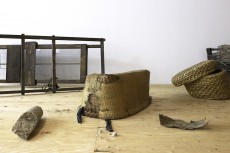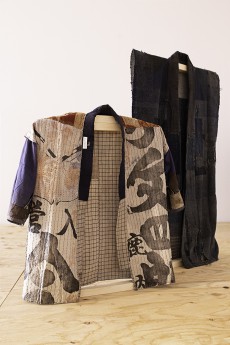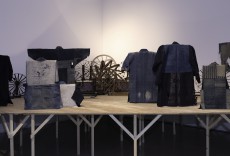
The Beginning of Life/Art: Cloth Weaves Our Times, from Aomori
May 7 (Thu)- August 30 (Sun), 2020
ENDO Kaori
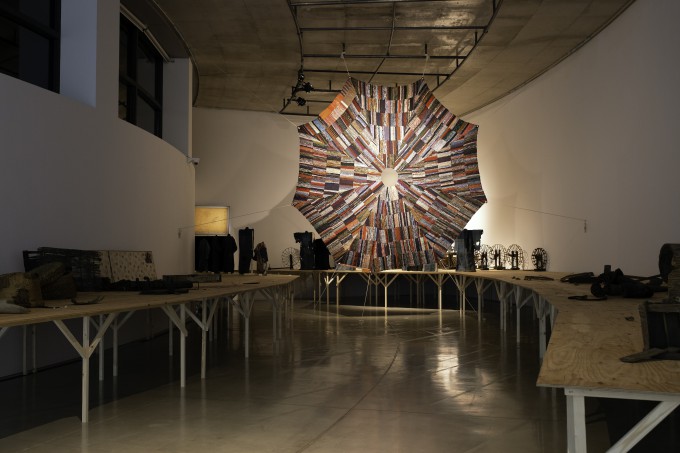
Flash and Parachute, 2020 Photo: Delphine Parodi
If no one made bombs and made only beautiful fireworks instead, wars would never have happened. - Kiyoshi Yamashita
Considering that complex social facts are woven in textiles, the textile/visual artist ENDO Kaori collects textiles and repeatedly uses and restores them, in her search for the essence of crafts, rooted in people’s life, through a contemporary art perspective. Inspired by the remark made by the painter Kiyoshi Yamashita (1922-1971), who is said to have started wandering about to escape from the draft during the Second World War, she created an installation themed around war and fireworks.
While there is a masterpiece of collage by Yamashita, called Nagaoka Fireworks (1950), one type of fireworks called ‘White Chrysanthemum’, which gets shot up at Nagaoka Firework Festival, commemorates victims of the Nagaoka air raid that happened on August 1st, 1945, right before the Second World War ended. Incidentally, this very place, Aomori, was also hit by a major air raid four days prior to the Nagaoka air raid and many people lost their life. The Japanese summer tradition: Fireworks - Their colorful flashes and blasts by bangers can move the audiences as well as remind them of air raids and wars.
For this occasion, Endo acquired unused second hand kimonos from all over the country including Aomori, tore them into strips, learned the Tsugaru Sakiori (Weaving) technique, and wove them into a parachute.
Parachutes were invented as a means to escape from airplanes and used to save people’s lives. Later on, parachute descent was developed as a way of transporting soldiers to attack enemy territories from the sky. As many predecessors have pointed out, the time-consuming weaving work somehow resembles the act of prayer.
From the craft objects used among ordinary people, archived in the collection of the Aomori city Board of Education, Endo selected damaged or broken agricultural equipment, which was passed down through many people’s hands, and various kimonos, which were worn with great care and changed through time.
One day by chance, told by an alumnus of Aomori Municipal Nagashima Elementary School, Endo encountered a pen drawing of fireworks, which is said to be the work of Kiyoshi Yamashita. All kinds of things migrate and similar things happen beyond time and place. Everything is related. Wars are not something that have ended. Endo makes textiles, uses them, and restores them. Following as extensions of these life activities, it seems that Endo is trying to continue living someone’s life.
Text: KEINO Yuka, Translation: NAGASAKA Aki
・Exhibited Cultural Properties
A pen-and-ink sketch attributed by YAMASHITA Kiyoshi (Owned by Aomori Municipal Nagashima Elementary School, 1958)
About 53 craft objects (Owned by Aomori City Board of Education) ※Refer to attached sheet
・Video
Shot and Edited by YOKOYAMA Masanori (YOKOYAMA DESIGN WORKS)
Shot of Nebuta Festival around 1970 by YAMAZAKI Tatsuo


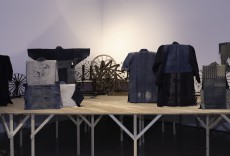


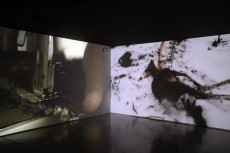
いのちの裂け目ー布が描き出す近代、青森から
2020年5月7日(木)~8月30日(日)
遠藤薫
ENDO Kaori
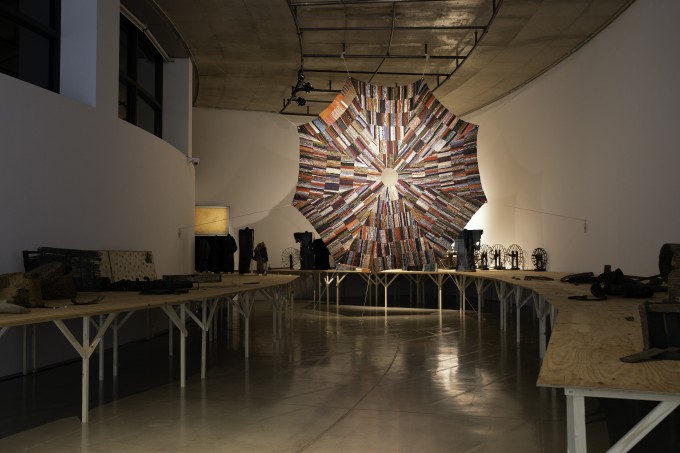
≪閃光と落下傘≫2020年
撮影:デルフィン・パロディ
みんなが爆弾なんかつくらないで きれいな花火ばかりをつくっていたら きっと戦争なんか起きなかったんだな―山下清
生活に根差した工芸の本質を現代美術的な視座から探るべく、テキスタイルに複雑な社会的事実が織り込まれていると考え、布を集め使用と修復の行為を繰り返す、工芸/美術作家の遠藤薫。彼女は、第二次世界大戦の徴兵を逃れるため放浪をはじめたとされる画家・山下清(1922-1971年)の言葉に触発され、戦争と花火に関するインスタレーションを制作しました。
山下の代表作である貼り絵に《長岡の花火》(1950年)がありますが、長岡の花火で打ち上げられる「白菊」は、第二次世界大戦終戦間近の1945年8月1日に起きた長岡空襲の被害者を慰霊するための花火です。ちなみにここ青森も長岡の4日前に大空襲を受け、大勢の人が亡くなりました。夏の風物詩である花火。その形色とりどりの閃光と雷薬による爆発音は、時に見る者を感動させ、時には空襲など戦争を連想させるものとなり得るでしょう。
遠藤は今回、もう着られなくなった着物を、青森を含む全国各地から譲り受け、裂き、津軽裂織の技術を学んで、落下傘(パラシュート)を織りあげました。飛行機からの脱出手段として、人命を守るために実用化された落下傘。その後、敵地を空から攻める兵士輸送の方法として落下傘降下は発達しました。長い時間のかかる織りの作業は、数多の先人たちが指摘するように、どこか祈りに似ています。そして、遠藤が青森市教育委員会蔵の民俗資料から選び出したのは、多くの人々の手を経て傷んでいる、もしくは壊れている農機具と、大切にまとわれてその時間の分だけ変化した着物の数々です。
ある日偶然、青森市立長島小学校の卒業生に教えられ、遠藤は山下清が描いたと伝えられる花火のペン画と出会うことになりました。あらゆる事物の移動によって、時と場所を超えて同じようなことが起こること。すべてが無関係ではないこと。戦争は決して終わったことではないこと。布を作り使い、なおす。そのような生活のなかの行為の延長線上で、遠藤は誰かの生の続きを生きようとしているかのようでもあります。
テキスト:慶野結香
・展示文化財
伝・山下清ペン画(青森市立長島小学校所蔵)昭和33(1958)年
民俗文化財約53点(青森市教育委員会所蔵)
・映像
撮影・編集:横山昌典(YOKOYAMA DESIGN WORKS)
ねぶた映像(昭和45(1970)年頃)撮影:山崎竜男
